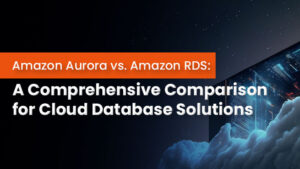
How to Apply Cybersecurity in Fintech for User Protection
Introduction As fintech evolves, it brings innovative financial solutions that enhance user convenience, such as mobile banking, digital lending, and secure payments. However, as financial
Big Savings! Get 50% OFF on all Online Courses. Use code: “SAVE50NOW” – Hurry Up Offer Ending Soon!

Introduction As fintech evolves, it brings innovative financial solutions that enhance user convenience, such as mobile banking, digital lending, and secure payments. However, as financial

Introduction In the realm of cloud computing, Amazon Web Services (AWS) offers a variety of managed database options that help organizations scale, secure, and optimize

Introduction In the ever-evolving landscape of cybersecurity, zero-day attacks pose a significant threat to businesses and individuals alike. A zero-day attack exploits a software vulnerability
Table of Contents
As cloud technologies continue to develop and mature, more and more businesses are looking to embrace cloud transformation to stay competitive. Cloud transformation has become an increasingly popular option as organizations continue to face pressure to do more with less. The cloud offers several advantages, including the ability to scale quickly and easily, reduced costs, and increased agility.
Organizations must consider their specific needs and objectives before embarking on a cloud transformation journey. In addition, they need to have the right team in place to ensure a successful transition. This article covers detailed information on Cloud transformation.
For further details, please visit the IPSpecialist website. IPSpecialist is the ideal place to begin your career if you are interested in Cloud Computing. Networking, cybersecurity, or related fields. We offer online courses, study guides, e-books, practice questions, exam-cram notes, and career guidance. Check out our Courses now!
Moving a company’s data, apps, and software to the cloud is known as cloud transformation. Although it seems simple, the switching process can get very tricky quickly. How cloud transformation and cloud migration are different from one another is a major point of concern.
Cloud migration, a crucial phase in the transformation process, is the process of moving data from a local server to the cloud. However, the migration process is only one aspect of cloud transformation. In contrast, the modernization and optimization of an organization’s data management, analytics, and security are necessary to support the company’s digital transformation goals.
Although cloud transformation is frequently seen as a cost-saving measure, it can also offer numerous additional advantages to enterprises, including:
Concerns about data security are frequent among businesses switching to the cloud. Moving data elsewhere could make it safer, although this may seem contradictory to some firms. Similarly, cybercriminals can more quickly access data stored on the computer by using attack vectors like malware and phishing emails.
Data kept in the cloud is more likely to be safeguarded by encryption and additional levels of security with the correct procedures and solutions in place, making it more difficult for hackers to obtain unauthorized access. Cloud hosting enables several backups of important data in addition to encryption and protection to lower the chance of data loss or expensive downtime in the case of a disaster.
Many businesses are finding that they must shift to the cloud to be competitive in today’s fast-evolving market. Cloud-based businesses differentiate themselves from their on-premises rivals by practically instantaneously scaling up to meet new priorities or projects rather than delaying IT infrastructure expansion for weeks or months.
Furthermore, the cloud frees IT staff to concentrate on innovations that advance the business rather than necessary infrastructure upkeep.
By allowing access to crucial data anytime, anyplace, 42% of firms mention this as a key reason for moving their operations to the cloud. Since data is stored centrally, the cloud can assist teams during times of crisis when working methods are likely to alter. Additionally, it supports businesses that operate remotely and across international boundaries.
Committing to cloud transformation could appear overwhelming, but with the right strategy and preparation, numerous pitfalls and obstacles can be avoided. The following are a few practices to ensure a successful transformation:
Most firms are currently shifting to new business models that emphasize the digitalization of business processes and extensive cloud deployments, making business process alignment with IT critical for any modern business.
The first step is identifying the firm’s objectives and the current systems, technology, and procedures. Next, establish priorities with representatives of the concerned departments by developing and documenting objectives.
What is strategically valuable to your organization should be determined by the user. Longevity and stability, quality of administrative support, technology compatibility, ease of deployment and upgrades, security procedures, and price are a few possible comparative points.
Even after the first transfer, thorough cloud usage optimization and monitoring can frequently lead to further cost savings. Focus on the metrics that will most influence the revenue or user experience when deciding which ones to examine. Additionally, it is crucial to regularly assess the health and functionality of the system to stop errors or problems from spreading.
Last but not least, the security of the cloud plays a crucial role in the success of a cloud transformation. Therefore, one should prioritize cloud security as part of the overall strategy and roadmap. Knowing the organization’s security weaknesses and desired future state usually starts with an impact study.
The cloud has become increasingly popular for businesses of all sizes in recent years. The cloud allows businesses to be more agile and quickly adapt to changing conditions. It also provides several other benefits, such as scalability, security, and cost-effectiveness.
The appropriate strategy and preparation might help any firm transform to the cloud and reach new heights. By using the cloud to disrupt the business, users are modernizing the technology and reinventing the entire organization. This encourages innovation, increases customer growth, and boosts the bottom line while empowering the company to become more resilient, agile, and disaster-proof.
© 2024 All rights reserved | Privacy Policy | Terms and Conditions | Sitemap | Cookie Policy




